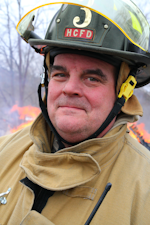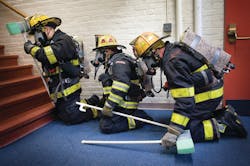With devices tracking everything from planes in the sky to stolen cars in a city to the tiniest of screws in a vast warehouse, one would think it would be easy to track firefighters inside buildings. It’s not.
Some of the brightest minds in the world who are working on this problem gathered at Worcester Polytechnic Institute (WPI) in Massachusetts Aug. 1 and 2 to discuss firefighter tracking and share technological advances. It was the sixth annual “Precision Indoor Personnel Location & Tracking International Workshop,” sponsored by the U.S. Department of Homeland Security and WPI. More than 145 people attended the workshop, including research and development scientists, manufacturers and those in the fire service who represent the end users.
The workshop was born out of the Dec. 3, 1999, tragedy where six Worcester firefighters died in a massive and complex vacant cold-storage warehouse. The firefighters initially entered searching for a homeless couple who were reportedly still inside the structure. The rescuers, and those who were sent into rescue the firefighters, got lost in the maze-like structure. The homeless people had long fled and were not in danger.
Touched by the loss, faculty and researchers at WPI decided to develop a firefighter tracking and location device, hoping to prevent future losses in similar situations. While it is a noble goal, the solution has been elusive, as illustrated by the more than 35 agencies represented at the workshop all saying a deployable, reliable product is a long way from going to market.
Tragedy Breeds Need
To illustrate the importance of a firefighter locator and tracker, Worcester Deputy Fire Chief John Sullivan recalled that fateful day when the firefighters were lost.
The building had 12-inch asphalt-impregnated cork on the walls with no windows and, at the time of the fire, an unknown number of floors and limited egress. It also had a fair amount of polystyrene in its construction, according to Sullivan.
“It was not an ordinary construction building,” he said. “We were facing a Class B fire.…We were never able to get the GPMs to BTUs to work. We were losing the firefight.”
In addition, the building was huge. Sullivan estimated it was the equivalent of 54 ranch-style homes. There were not enough firefighters on the scene to do a safe and effective search, he said. That’s why it would have been beneficial to have a firefighter locator tool available.
“You need to know how intensely important it is for us to have some sort of 3-D tracking device,” Sullivan said. “We can’t do it ourselves. We need you.”
Make no mistake, researchers and manufacturers are looking at existing technologies for the answers and some hold promise, but there haven’t been any revolutionary breakthroughs yet. While technology has made it possible to track planes, ships, trucks and even people outside using global position satellite (GPS) technology, GPS doesn’t work inside. Research and development call that GPS-denied or GPS-jammed locations. The inside of a building like Worcester’s cold-storage building is a perfect example.
A variety of technologies are being used to create firefighter tracking, including radio frequencies, inertial-based, dead-reckoning systems, with most promising a combination or suite of technologies. Tracking a firefighter in a building, with the receiver also inside, is very close to being perfected, but transmitting that signal effectively to the outside of a building to an incident commander or safety officer (with 80 percent or better accuracy) has proven to be the most challenging aspect of the solution.
Firefighters and end users seem to be divided about what is acceptable and what level of accuracy will work. Some who attended the conference said they needed the “breadcrumb” trail that showed exactly where the firefighter had traveled and his location. Others said they would be happy knowing the quadrant and floor on which a downed firefighter is located. Manufacturers are striving for pinpoint accuracy to within three feet, a goal that has proven elusive thus far.
Some of the solutions have required elaborate setup with sensors, beacons and antenna arrays, which are all fine for testing and research, but firefighters who were part of the conference said everything has to be ready to go when firefighters arrive at the scene. They said they don’t have time to deploy a tracking system and do all the other customary firefighting tasks, especially when firefighting staffs are being cut everywhere and even volunteers are hard to retain.
“We have trouble keeping the guys in their seatbelts and getting the truck stopped before they are jumping out and going to work,” said Battalion Chief Dean Cox of Fairfax County, VA, Fire & Rescue. “Ideally, having the system going before we get there would be best.”
Test Runs for Technologies
One manufacturer working on a user-friendly device is MSA, a maker of personnel protection equipment (PPE). MSA demonstrated its LS1 Personnel Location System at the WPI conference. It’s based on an inertial navigation system, transmitting a “breadcrumb-like” trail from the user to an incident commander, viewed on a computer screen. During a video presentation of the device, contrails from the initial-entry team into a building were traced on the computer screen and then replicated by a rapid intervention team (RIT) who went in to find a simulated down firefighter.
Another system was demonstrated by Trimble Navigation, a provider of advanced positioning solutions. The Trimble system works on a reverse radio frequency identification tag system. Using hundreds of RF tags installed a day before in the Atwater Kent building on the WPI campus, Trimble equipment guided rescuing firefighters to a “down” comrade. The company’s technology holds promise for new construction in which RF tags can be installed initially rather than retrofitted.
Other kinds of technologies being considered include UHF and VHF radio frequency transmissions, a personal “dead-reckoning” system using an inertial measurement unit (IMU) in the boot of the firefighter and near-field electromagnetic ranging systems.
As part of the overall firefighter safety initiative, manufacturers are developing equipment to monitor the overall physical well being of responders. One presenter at the conference was Globe Manufacturing. Mark Mordecai, Globe’s director of business development, said the company has been working on a project called wearable advanced sensor platform (WASP), which is designed to monitor firefighters’ physiology while on the job.
“This is the next step in keeping firefighters safe,” Mordecai said, noting that finding down firefighters is obviously important, but so is keeping track of a firefighter’s health.
The technology, according to Mordecai, will be incorporated in a flame-resistant, base-layer shirt that will be worn as part of the responders’ PPE. That undergarment will be wired with sensors that can measure heart rate, body temperature, respiration and other vital signs.
Globe has partnered with Zephyr Technology for the physiological monitoring and data transmission technology that is now integrated into Zephyr’s BioHarness. Zephyr pioneered remote physiological monitoring. The concept is to monitor firefighters and transmit those vital signs back to a safety officer so command will know when someone is in trouble and appropriate action needs to be taken. With about half of fallen firefighters dying as a result of heart attacks, Mordecai said this kind of technology is needed in the fire service. As for timing, Mordecai said products will be available for sale in 2012 and will be able to be used with new gear as well as retrofitted to existing in-service gear.
The Globe WASP system will be ready to integrate with other relevant technology, including location and tracking devices as part of the DHS Physiological Health Assessment Sensor for Emergency Responders (PHASER), which goes hand-in-hand with the department’s Geospatial Location Accountability and Navigation System for Emergency Responders (GLANSER), the driving force behind the firefighter locating system.
One of the hosts of the conference, Jalal Mapar, program manager at DHS’s Science and Technology Directorate, is the head of the GLANSER team charged with developing the firefighter locating device. He said he understands the frustration of responders who wanted this technology yesterday. Nevertheless, Mapar said, there is a genuine disconnect between expectations and funding. And, despite a lack of consensus about what is good enough for tracking accuracy, GLANSER will have at least a prototype at next year’s conference. “We are being forced to move,” he said. “We can no longer have five-year tails on projects. I understand and I promise, next year you will have something to test and to see.”

Ed Ballam
Ed Ballam served as associate editor for Firehouse. He is the assistant chief of the Haverhill Corner, N.H. Fire Department, and a National Registered EMT. He is also a Deputy Forest Fire Warden for the New Hampshire Division of Forests and Lands. Professionally, he's been a journalist for over 35 years working for a variety of publications, including employment as managing editor of a national fire service trade journal for more than a decade.








